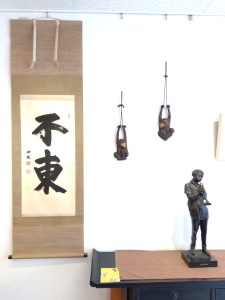「おはぎ」と「ぼたもち」の違いとは(愛知県名古屋市千種区姫池通 骨董買取 古美術風光舎)
2023.09.21
みなさまこんにちは、スタッフTでございます。
本日からブログデビューいたしました。みなさま、どうぞお手柔らかにお願いいたします。
ニュースでは過去最も遅い猛暑日の記録更新が伝えられてはおりますが、暦の上では彼岸入りいたしました。「暑さ寒さも彼岸まで」とは言い得て妙ですね。

お彼岸といえば、お墓参りや法要などご先祖様と向き合う方も多いのではないでしょうか。またお彼岸のお供え物といえば、お餅をあんこで包んだ甘いおはぎが定番ですね。
おはぎと似た食べ物に、ぼたもちがありますが、どちらもお彼岸にお供えする食べ物。ぼたもちは春のお彼岸に、おはぎは秋のお彼岸にお供えするという違いがありますが、なぜ違うのかちょっと気になってきました。
春のお彼岸にお供えするぼたもちの由来になっているのは、春の花である「牡丹」のようです。秋のお彼岸のお供え物であるおはぎの名前は、秋の七草のひとつでもある「萩の花」にちなんでいるようで、このようにお彼岸の季節に美しく咲く花になぞらえたものをお供えして、みなさまご先祖様を供養しているようですね。
おはぎとぼたもちの違いは名前の由来だけでなく、作り方にもあるようでして、粘りと弾力がある食感が特徴のもち米と、一般的に食事に用いられているうるち米とを混ぜ合わせて炊き、粒感が残る程度について丸めて餅にする点は、おはぎとぼたもちで共通の作業のようですね。大きな違いは、餅を包むあんこにあり、おはぎはつぶあんで餅を包みますが、ぼたもちはこしあんを用いるとのことです。

小豆の収穫時期は秋であるため、秋のお彼岸にお供えされるおはぎは、収穫したばかりの小豆が使われます。新鮮な小豆は皮がやわらかく、炊くと皮ごと食べられるので、おはぎのあんこは皮が残っているつぶあん。
一方、春のお彼岸のぼたもちに使う小豆は収穫から時間が経ち、乾燥して皮が固くなっています。つぶあんにすると皮が口に残って食べづらいため、ぼたもちは皮を取り除いたこしあんを使うのだそうです。
さらに、おはぎとぼたもちは形にも違いが見られ、大輪の花を咲かせる牡丹に似せて丸く大きく作るぼたもちに対して、おはぎは細長い花びらを持つ萩の花をイメージして俵形に作られるそうです。地域によって呼び名が違うと思っておりましたが、このうような違いがあったんですね。
そんなわけで、私も作ってみようとはしましたが少しハードルが高そうですので、今年はまずは和菓子屋へ足を運ぶことからにしてみようと思っています。
ではでは、また。
Hello everyone, this is Staff T.
I have made my blog debut today. I hope you will all take it easy on me.
The news is reporting that we have broken the record for the slowest heat wave in history, but the calendar says that we have reached the equinoctial equinox. It is a strange saying that “hot and cold lasts until the equinoctial week.
Speaking of the far shore, many of you may be facing your ancestors by visiting graves or holding memorial services. The standard offering on the far shore is sweet o-hagi (rice cakes) wrapped in red bean paste.
Another food similar to o-hagi is botamochi. Both of these foods are offered on the far shore, but there is a difference in that botamochi is offered on the spring far shore and ohagi is offered on the fall far shore, and I have been wondering why the difference.
Botamochi offered on the spring Ohigan is derived from the spring flower “Botan” (peony). The name of the autumnal offering, ohagi, comes from hagi, one of the seven flowers of autumn, and it seems that everyone makes offerings to their ancestors by offering something that is compared to the beautiful flowers that bloom on the far shore.
The difference between “ohagi” and “botamochi” is not only in the origin of the name, but also in the way they are made. Ohagi and botamochi share a common point: glutinous rice, which is characterized by its stickiness and elastic texture, is cooked with a mixture of rice and uruchi rice, which is commonly used for meals, and the mixture is rolled into a rice cake with just enough graininess remaining. The major difference lies in the bean paste that envelops the mochi. While o-hagi uses mashed sweet bean paste to wrap the rice cake, botamochi uses koshi-an (sweet red bean paste).
Because azuki beans are harvested in the fall, freshly harvested azuki beans are used for ohagi, which are offered on the autumnal equinox. Fresh azuki are soft-skinned and can be eaten with the skin when cooked, so the bean paste used for ohagi is tsubu-an, which still has the skin.
On the other hand, azuki beans used for botamochi on the far shore of spring have long since been harvested and their skins have become dry and hard. The skin remains in the mouth when the botamochi is made with tsubu-an, making it difficult to eat, so the botamochi is made with koshi-an, which has the skin removed.
Furthermore, the shape of botamochi differs from that of o-hagi. Botamochi is made round and large to resemble a peony with a large flower, while o-hagi is made in the shape of a bale to resemble a bush clover flower with long, thin petals. I had thought that the names for these sweets differed depending on the region, but I was surprised to learn that there was such a difference.
See you soon.
*******************
ご実家の整理やお片付けなどをされている方のご相談などが多くございます。
お片付けなどくれぐれもご無理のないようになさってくださいませ。
風光舎では古美術品や骨董品の他にも絵画や宝石、趣味のお品など様々なジャンルのものを買受しております。
お片付けをされていて、こういうものでもいいのかしらと迷われているものでも、どうぞお気軽にご相談下さいませ。
また風光舎は、出張買取も強化しております。ご近所はもちろん、愛知県内、岐阜県、三重県その他の県へも出張いたします。
まずは、お電話お待ちしております。
愛知県名古屋市千種区姫池通
骨董 買取【古美術 風光舎 名古屋店】
TEL052(734)8444
10:00-17:00 OPEN
#出張買取#骨董#古美術#骨董品#絵画#版画#茶道具#刀剣#彫刻

